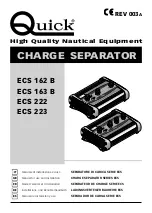
Page 9
Hot and Cold Water System
General
A schematic layout of the hot and cold water services in a typical small dwelling is
shown below. PulsaCoil BP will operate at mains pressures as low as 1.5 bar and as
high as 5 bar although the recommended range is 2-3 bar dynamic at the appliance.
It is also important to check that all other equipment and components in the hot
and cold water system are capable of accepting the mains pressure available to the
property. If the mains pressure can rise above 5 bar or the maximum working pressure
of any item of equipment or component to be fi tted in the system, a pressure limiting
(reducing) valve set to 3 bar will be required.
If you encounter a situation where the water pressure is adequate but fl ow rates are
poor please contact our technical helpline for details of an eff ective solution.
No check valve or similar device should be fi tted on the cold water supply branch to
the PulsaCoil BP.
The Building Regulations L1A:
New dwellings/L1B: Existing dwellings and the
requirements set out in the Domestic Heating Compliance Guide specify that “where
the mains water hardness exceeds 200ppm provision should be made to treat the feed
water to water heaters and the hot water circuit of combination boilers to reduce the
rate of accumulation of lime scale”.
To comply with this requirement the hardness of the mains water should be checked
by the installer and if necessary the optional factory fi tted in-line scale inhibitor should
be specifi ed at the time of order for hardness levels between 200 and 300 ppm (mg/l).
Where the water is very hard ie 300ppm (mg/l) and above the optional polyphosphate
type, inhibitor should be specifi ed at the time of order. However, this will need to be
fi tted by the installer at a suitable point in the cold water supply to the appliance.
The hot water flow rate from the PulsaCoil
BP is directly related to the adequacy of the
cold water supply to the dwelling. This must
be capable of providing for those services,
which could be required to be supplied
simultaneously, and this maximum demand
should be calculated using procedures defi ned
in BS 6700.
If a water meter is fi tted in the service pipe,
it should have a nominal rating to match the
maximum hot and cold water peak demands
calculated in accordance with BS 6700. This
could be up to 60ltr/min in some properties.
Note:
The diagram below shows the Top up
cistern with ballvalve and warning/overfl ow
pipe. The ballvalve/overflow connector can
be supplied as an optional extra if required.
However, the standard preferred arrangement
is for the cistern to be manually fi lled from a
temporary hose connection fi tted with a double
check valve.
The cistern must not be fitted more than 6
metres above the PulsaCoil BP appliance itself.
Warning/
overflow
pipe
MCWS
Safety/open vent
Shower
Expansion/
cold feed
Second
dwelling
Pressure limiting valve
NOT REQUIRED at
pressures below 5 bar
unless any components
have a lower
maximum working
pressure
Double check valve
NOT REQUIRED unless
pipe supplies more
than one dwelling
‘a’ - flow regulator recommended for
better balance of hot and cold
water supplies
MCWS
supply
pipe
Sink
H C
a a
SV
a a
a a
Bath
H C
Hand basin
H C
WC - fitted
with BS1212
ballvalve
C
Figure 1.5
Typical hot and cold water distribution
PULSACOIL BP
Check valve
NOT REQUIRED unless
chemical water
treatment unit is fitted
a
Top up cistern
DESIGN
SYSTEM DETAILS
Summary of Contents for PulsaCoil PCBP 120
Page 20: ...Page 20 APPENDIX APPENDIX B ...
Page 22: ...Page 22 NOTES ...
Page 23: ...Page 23 NOTES ...










































